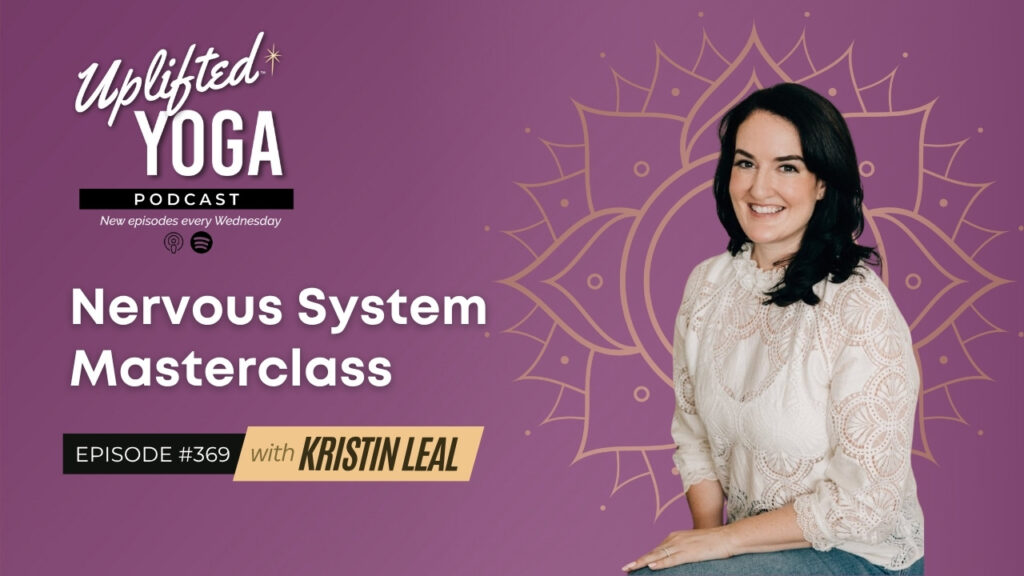
If you’re an Uplifted alumni you’ll recognize today’s guest from inside the training…Kristin Leal!! 🎉I could talk to Kristin about anatomy and the nervous system for hours, and I’m so excited that she came on the podcast to enlighten us all with her vast knowledge. Kristin is going to delve into the complexities of the nervous system, particularly focusing on the autonomic nervous system and its two branches: the sympathetic and parasympathetic systems. She’ll discuss the complexities of the human stress response and the importance of understanding these systems in the context of yoga to help regulate your nervous system.
Get your notebook ready and learn:
🔹How the nervous system is interconnected with all bodily systems.
🔹What Vagal tone is and how it’s an important indicator of overall health and well-being.
🔹The way burnout manifests as inactivity or excessive rest without true recovery.
✨ Make your yoga practice 2x more potent in 1/2 the time with my Free Yoga Transformational Portal
GUEST EXPERT: Kristin Leal | @metaanatomy
Kristin is in love with how esoteric anatomy links so effortlessly to Western anatomy, and her MetaAnatomy™ trainings blend serious scientific knowledge with a sense of humor and a deep connection to the divine within us all. As the creator of the Kaya Yoga 200- and 300-hour teacher training, she’s certified over 5,000 yoga teachers since 2005. Kristin also holds certifications in Reiki, Thai massage, neuromuscular and myofascial release, and is a co-author of the book The Yoga Fan (2003) and the author of MetaAnatomy™ (2014).
Explore Kristin’s Offerings: https://www.kristinleal.com/
Get Kristin’s Books:
MetaAnatomy
Yoga Fan: Practice Guide For Everyday
FREE Practice: Somatic Release Meditation for Trauma | Vagus Nerve Reset to Gently Free Trapped Emotions
Relevant Blog: 3 Easy Somatic Exercises To Soothe Your Nervous System
Relevant to Today’s Episode:
🐍 Kundalini 200-hour YTT
✅ 200-hour Online Yoga Teacher Training
🔮 300-hour Online Yoga Teacher Training
🎧 Also Listen to:
#311 – Embodiment, Expression & Femininity with Alexandra Roxo
#345 – Somatic Shaking: What Is It? Why Does it Work?
#350 – Do a “Yoga Life Makeover” with Corinne Maples
© 2025 Uplifted Yoga | BrettLarkin.com
Experience 3 Training Videos from Inside My 200-Hour Online YTT 👇
Transcript:
Brett:
Hello, yoga family! Welcome back to the show. You are in for a treat. And Uplifted alumni — you’re gonna recognize today’s guest from many of our yoga teacher trainings. It’s Kristin Leal.
I could talk to Kristin about anatomy all day long, but we wanted to create a podcast that really dives into the nervous system. Because who doesn’t need a review on the nervous system — especially if you’re teaching yoga?
Or if you’re considering training, this is a great example of the kind of topics we nerd out on deeply. Today, we’re going into the complexities of the human stress response. We’re going to talk about vagal tone, and explore how burnout can manifest as either inactivity or excessive rest — and how neither of those things result in true recovery.
Enrollment for all our summer trainings is now closed, but it’s the perfect time to start thinking about taking training this fall. The best part of the Uplifted program is that the minute you sign up, you get access to all the videos — you can download them to your phone or stream them on your computer or TV. So you can have a total binge-watching experience with the home study portion. Plus, the manual gets shipped right to you.
So maybe this summer, you dive into the materials — and then the live calls officially start for you in September.
As always, thank you so much for being here. Don’t forget to like, subscribe, and support the show. Leave a review wherever you’re listening to this podcast.
And now… let’s get into all things nervous system with Kristin Leal.
Brett:
Kristin, welcome to the Uplifted Podcast. I’m so happy to have you in the podcast house!
Kristin:
I’m really happy to be here with you. Thanks for having me.
Brett:
So we’re going to talk about the nervous system. I feel like it’s covered in yoga teacher training — you teach it in all of ours — but we always need a review. There are a lot of terms that can feel overwhelming. And there’s more and more talk about the vagus nerve. Like when I first studied the nervous system, no one was talking about the vagus nerve. I mean, maybe you were… but 15 years ago, it wasn’t such a big piece of it.
Kristin:
Yeah. Hmm. Hey!
Brett:
That might be an interesting conversation too — how our understanding of the nervous system has evolved in the yoga world over the past 10 or 15 years. You’ve trained so many teachers. Where would you start for a nervous system review? Probably with the ANS, right?
Kristin:
Yeah, it’s a huge topic. And yes, the vagus nerve is all the rage — and has been for the last decade or more. I’m happy to talk all things nervous system with you and your community.
To study it, we often break the body into systems — like muscular or skeletal — which helps us organize information. But it belies the truth: you can’t actually separate the nervous system from the rest of the body with any good result. It has tentacles in everything — muscles, bones, respiration, digestion, perception, emotions.
It’s like an octopus with a million arms. Its reach is vast.
So for study’s sake, we break it into two big hunks: the Central Nervous System (brain and spinal cord), and the Peripheral Nervous System (everything else).
From there, we can categorize the PNS into the voluntary nervous system and the autonomic (or involuntary) nervous system — what we call the ANS.
Brett:
Hence the ANS I started with — see, I’m such a good student.
Kristin:
Yes! But I prefer the term autonomic instead of involuntary. “Involuntary” sounds like we have no interaction with it — throw up your hands, nothing you can do — but that’s not true. It’s a very hackable system.
It responds to what’s happening around us, inside us, and even just our thoughts. The ANS is typically divided into the Sympathetic Nervous System (fight or flight) and the Parasympathetic Nervous System (rest and digest).
But the terminology can be misleading. Fight-or-flight sounds bad. Rest-and-digest sounds like the goal. But both are essential! I prefer to say: Engagement mode (sympathetic) and Relaxation mode (parasympathetic).
You and I are in engagement mode right now — we’re talking, thinking, sharing. Humans are meant to be in engagement about half the day.
Brett:
That reminds me of a YouTuber who said her ideal superpower would be: “To have energy whenever I needed it, and fall asleep instantly whenever I wanted.” That really is the cultural problem — we chug coffee to energize and pop sleeping pills to unwind.
Kristin:
Exactly.
Brett:
So helping students understand that yoga can re-pattern this — help you wake up and wind down naturally — is huge. And I love your phrasing: instead of “fight-or-flight,” we’re developing a sweet relationship with sympathetic activation.
Kristin:
Yes. In an ideal world, we’d peacefully pendulum between sympathetic and parasympathetic throughout the day. But the world isn’t ideal — we have kids, jobs, partners. We get stuck in engagement mode. And that wears us down.
We burn through our reserves so when we actually need a full-blown stress response, like a tiger is chasing us, we don’t have the juice.
Brett:
Like someone who drinks 6 cups of coffee a day won’t get a boost when they actually need one.
Kristin:
Exactly. I love coffee too, but if I overdo it — I get jittery, heart racing, brain racing. That’s a hyper-reactive sympathetic system.
Yoga helps us train how we respond in stress. Even something like chair pose — if you’re in it for five long breaths, you’re not in “rest and digest!” But the mental attitude your teacher brings — “Where’s your breath? Where’s your mind?” — helps you build awareness.
That pause… that ability to choose a response instead of reacting — that’s the gift.
Brett:
Right! It’s not just about getting into rest mode. It’s about how we handle stress while we’re in it.
Kristin:
Yes. And doing it in community is also key. Practicing yoga in a group helps elicit a parasympathetic response.
Biochemically, after a stressor passes, the body starts dripping oxytocin — the bonding hormone. You seek social support. That’s why we tell someone the scary story — “There was a tiger!” — and their compassion (eye contact, touch, voice) helps regulate us.
Brett:
That’s why I love the somatic approach. It’s about closing the stress cycle. I actually use my husband this way — if I can’t fall asleep and he’s already relaxed, I snuggle him like a therapy animal. My breathing slows with his.
Kristin:
That’s beautiful co-regulation.
Brett:
Yes — it’s funny because folks with Kundalini awakenings often go to wild, stimulating festivals. But what they really need is to rub up on someone very boring and very regulated. With consent, of course.
Kristin:
Yes, always consent. But totally!
Brett:
Let’s talk about Kundalini. Some say when we hold poses for several minutes — like arms up — the body perceives it as danger, and we get a hormonal flood. Then when we release the pose, we get a wave of feel-good hormones. Is that what’s happening?
Kristin:
It’s possible. Everyone’s different. But yes — strong sympathetic activation can trigger cortisol, adrenaline, even endorphins. Cortisol is like an anti-inflammatory. Your body’s preparing for damage before it even happens. So yes, it could explain the release you feel afterward.
Brett:
That’s what I think too. It’s repatterning: telling the body, “Yes, we’re under stress, but we’re okay.” You create nerves of steel.
Can we talk about depression for a moment? Is it stuck parasympathetic? While anxiety is stuck sympathetic?
Kristin:
It’s trickier than that. Prolonged cortisol wears down the hippocampus — the memory center of the brain. That’s common in depression: brain fog, memory loss.
So burnout may look like “resting” on the couch, but it’s not true rest. You’re not recovering. You’re marinating in stress hormones. That’s not parasympathetic — it’s a red flag that you’ve been in overdrive too long.
Brett:
Yes! Sometimes I need Netflix before I can even think about Nidra. What’s actually happening when we’re staring at the wall like zombies?
Kristin:
That moment of nothing is human. It’s a staging area before the next right step. We need decompression. Don’t let the “perfect self-care” list trick you. Sometimes we need 30 minutes to reset, then we can do something truly nourishing — like a walk, legs-up-the-wall, or breathwork.
Brett:
Yes — I like the way you phrased it. It’s decompression.
And before we wrap — let’s talk vagus nerve. It’s so trendy now. What’s the deal?
Kristin:
Great question. First, it’s a pair of nerves — not “Vegas” like the city. “Vagus” means wanderer, like vagabond. It exits the brainstem and wanders through the face, heart, lungs, and digestive organs. It’s mostly parasympathetic in nature.
And here’s the kicker: about 80% of its signals go from the body to the brain. That flips the script. Your body isn’t just obeying commands — it’s sending vital status reports up to your brain all the time.
Brett:
That’s why I love using it in somatic training. It changes how we relate to our bodies.
Kristin:
Exactly.
Brett:
Okay but what does “stimulating the vagus nerve” actually mean?
Kristin:
It doesn’t have to be complicated. Things like:
- Deep breathing with a longer exhale
- Humming
- Left nostril breathing
- Being in community
These all activate the vagus nerve. They build vagal tone — your nervous system’s ability to bounce between activation and rest.
Brett:
Wait, tell us more about vagal tone.
Kristin:
Sure! Every inhale speeds up your heart. Every exhale slows it down. The bigger that difference, the better your vagal tone.
Higher vagal tone = better stress resilience, lower risk of disease, stronger emotional support, and even more happiness.
Brett:
That’s counterintuitive! I thought we wanted equanimity. But you’re saying — we want a wide range.
Kristin:
Yes! Life isn’t grayscale — we’re meant to feel the full rainbow.
Engage deeply. Then rest deeply. Learn how to do both with elegance. That’s the practice.
Brett:
Yes — it’s so tantric. The rainbow of human experience.
And this is just a tiny glimpse of your knowledge! You teach entire 3-hour modules on the knee or the brain. You’re in nearly all our trainings — 200, 300, Kundalini — and I’m getting you in Somatic next!
But for folks who want to find you directly, how can they work with you?
Kristin:
Thank you. Your Uplifted community is one of my favorites. There’s so much heart.
If people want to study more, they can visit kristinleal.com. You’ll find my books, online courses, and private session info there.
Brett:
And we’ll link to everything in the show notes. Thank you so much for being here and sharing this wisdom.
Kristin:
It’s about learning to know yourself — through many different maps. I hope to meet you on the mat.
Brett:
Yes. Thank you, everyone, for listening to the very end. Namaste.









